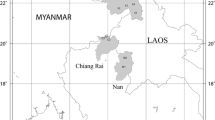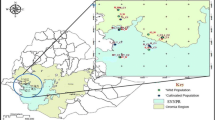Abstract
Crop-to-wild introgression may play an important role in evolution of wild species. Asian cultivated rice (Oryza sativa L.) is of a particular concern because of its cross-compatibility with the wild ancestor, O. rufipogon Griff. The distribution of cultivated rice and O. rufipogon populations is extensively sympatric, particularly in Asia where many wild populations are surrounded by rice fields. Consequently, gene flow from cultivated rice may have a potential to alter genetic composition of wild rice populations in close proximity. In this study, we estimated introgression of cultivated rice with O. rufipogon based on analyses of 139 rice varieties (86 indica and 53 japonica ecotypes) and 336 wild individuals from 11 O. rufipogon populations in China. DNA fingerprinting based on 17 selected rice simple sequence repeat (SSR) primer pairs was adopted to measure allelic frequencies in rice varieties and O. rufipogon samples, and to estimate genetic associations between wild and cultivated rice through cluster analysis. We detected consanguinity of cultivated rice in O. rufipogon populations according to the admixture model of the STRUCTURE program. The analyses showedz that four wild rice populations, DX-P1, DX-P2, GZ-P2, and HL-P, contained some rare alleles that were commonly found in the rice varieties examined. In addition, the four wild rice populations that scattered among the rice varieties in the cluster analysis showed a closer affinity to the cultivars than the other wild populations. This finding supports the contention of substantial gene flow from crop to wild species when these species occur close to each other. The introgressive populations had slightly higher genetic diversity than those that were isolated from rice. Crop-to-wild introgression may have accumulative impacts on genetic variations in wild populations, leading to significant differentiation in wild species. Therefore, effective measure should be taken to avoid considerable introgression from cultivated rice, which may influence the effective in-situ conservation of wild rice species.
Similar content being viewed by others
References
Bartsch D, Lehnen M, Clegg J, Pohl-Orf M, Schuphan I, Ellstrand NC (1999) Impact of gene flow from cultivated beet on genetic diversity of wild sea beet populations. Mol Ecol 8:1733–1741
Bonnet E, Van De Peer Y (2002) Zt: a software tool for simple and partial Mantel tests. J Stat Software 7:1–12
Chase MR, Moller C, Kessell R, Bawa KS (1996) Distant gene flow in tropical trees. Nature 383:398–399
Cheng KS, Wang XK, Zhou JW (1984) Studies on indigenous rices in Yunnan and their utilization. 2. A revised classification of Asian cultivated rice (in Chinese). Acta Agron Sinica 10:271–280
Dieringer D, Schlötterer C (2003) Microsatellite analyser (MSA): a platform independent analysis tool for large microsatellite data sets. Mol Ecol Notes 3:167–169
Ellstrand NC, Schierenbeck KA (2000) Hybridization as a stimulus for the evolution of invasiveness in plants. Proc Nat Acad Sci USA 97:7043–7050
Ellstrand NC, Prentice HC, Hancock JF (1999) Gene flow and introgression from domesticated plants into their wild relatives. Ann Rev Ecol Syst 30:539–563
Felsenstein J (1993) PHYLIP (Phylogeny Inference Package) Version 3.6. Department of Genetics, University of Washington, Seattle
Gao LZ (2004) Population structure and conservation genetics of wild rice Oryza rufipogon (Poaceae): a region-wide perspective from microsatellite variation. Mol Ecol 13:1009–1024
Gao LZ, Hong DY, Ge S (2000) Allozyme variation and population genetic structure of common wild rice Oryza rufipogon Griff. in China. Theor Appl Genet 101:494–502
Garris AJ, Tai TH, Coburn J, Kresovich S, McCouch S (2005) Genetic structure and diversity in Oryza sativa L. Genetics 169:1631–1638
Glaszmann H (1987) Isozymes and classification of Asian native rice varieties. Theor Appl Genet 74:21–30
Goldstein DB, Ruiz Linares A, Cavalli-Sforza LL, Feldman MW (1995) An evaluation of genetic distances for use with microsatellite loci. Genetics 139:463–471
Jarvis DI, Hodgkin T (1999) Wild relatives and crop cultivars: detecting natural introgression and farmer selection of new genetic combinations in agroecosystems. Mol Ecol 8:159–173
Kalinowski ST (2005) HP-RARE1.0: a computer program for performing rarefaction on measures of allelic richness. Mol Ecol Notes 5:187–189
Kiang YT, Antonovics D, Wu L (1979) The extinction of wild rice (Oryza perennis formasana) in Taiwan. J Asian Ecol 1:1–19
Ladizinsky G (1985) Founder effect in crop–plant evolution. Econ Bot 39:191–199
Lu BR, Song ZP, Chen JK (2003) Can transgenic rice cause ecological risks through transgene escape? Proc Nat Sci 13:17–24
Lu BR, Snow AA (2005) Gene flow from genetically modified rice and its environmental consequences. BioScience 55:669–678
Mantel N, Valand RS (1970) A technique of nonparametric multivariate analysis. Biometrics 26: 547–558
Morishima H, Barbier P (1990) Mating system and genetic structure of natural populations in wild rice, Oryza rufipogon. Plant Species Biol 5:31–39
Naredo MEB, Juliano AB, Lu BR, Jackson MT (1997) Hybridization of AA genome rice species from Asia and Australia I. Crosses and development of hybrids. Genet Resor Crop Evol 44:17–23
Nei M (1978) Estimation of average heterozygosity and genetic distance from a small number of individuals. Genetics 89:583–590
Normile D (1997) Archaeology—Yangtze seen as earliest rice site. Science 275:309–310
Oka HI (1988) Origin of cultivated rice. Scientific Societies Press, Tokyo
Oka HI, Morishima H (1967) Variation in the breeding systems of a wild rice, Oryza perennis. Evolution 21:249–258
Oka HI, Chang WT (1961) Hybrid swarms between wild and cultivated rice species, Oryza perennis and O. sativa. Evolution 15:418–430
Page RDM (1996) Treeview: an application to display phylogenetic trees on personal computers. Comp Appl Biosci 12:357–358
Pritchard JK, Stephens M, Donnelly P (2000) Inference of population structure using multilocus genotype data. Genetics 155:945–959
Richard IM, Richard JA (2000) Origin and evolution of invasive naturalized material of Rhododendron ponticum L. in the British Isles. Mol Ecol 9:541–556
Song ZP (2001) Gene exchange between Oryza rufipogon and cultivated rice O. sativa under controlled conditions. PhD thesis in Wuhan University of China
Song ZP, Lu BR, Chen JK (2004b) Pollen flow of cultivated rice measured under experimental conditions. Biodivers Conserv 13:579–590
Song ZP, Lu BR, Zhu YG, Chen JK (2002) Pollen competition between cultivated and wild rice species (Oryza sativa and O. rufipogon). New Phytol 153:289–296
Song ZP, Lu BR, Zhu YG, Chen JK (2003b) Gene flow from cultivated rice to the wild species Oryza rufipogon under experimental filed conditions. New Phytol 157:657–665
Song ZP, Xu X, Wang B, Chen JK, Lu BR (2003a) Genetic diversity in the northernmost Oryza rufipogon populations estimated by SSR markers. Theor Appl Genet 107:1492–1499
Song ZP, Lu BR, Wang B, Chen JK (2004a) Fitness estimation through performance comparison of F1 hybrids with their parental species Oryza rufipogon and O. sativa. Ann Bot 93:311–316
Song ZP, Li B, Chen JK, Lu BR (2005) Genetic diversity and conservation of common wild rice (Oryza rufipogon) in China. Plant Species Biol 20:83–92
Ting Y (1957) The origin and evolution of cultivated rice in China (in Chinese with English abstract). Acta Agron Sinica 8:243–260
Wang XK, Sun CQ (1996) Origin and differentiation of Chinese cultivation rice (in Chinese). China Agricultural University Press, Beijing
Weckworth BV, Talbot S, Sage GK, Person DK, Cook J (2005) A signal for independent coastal and continental histories among North American wolves. Mol Ecol 14:917–931
Wu MS (1990) Proceedings of wild rice resources researches. China Scientific and Technological Press, Beijing
Yeh FC, Yang RC, Boyle T (1999) Microsoft Window-based freeware for population genetic analysis (POPGENE), ver.1.31. ftp://ftp.microsoft.com/softlib/MSLFILES/HPGL.EXE
Zhang QF, Maroof M, Lu TY, Shen BZ (1992) Genetic diversity and differentiation of indica and japonica rice detected by RFLP analysis. Theor Appl Genet 83:495–499
Zhu MY, Wang YY, Zhu YY, Lu BR (2004) Estimating genetic diversity of rice landraces from Yunnan by SSR assay and its implication for conservation. Acta Bot Sinica 46:1458–1467
Acknowledgements
This research was supported by the National Natural Science Foundation of China (Grant no. 30300019, 30125029), Ministry of Science and Technology (Grant no. 2006CB100205), and Shanghai Commission of Science and Technology (Grant no. 03dz19309 and 03DJ14014). We thank Jiuhuan Feng and Dafang Cui for their assistants in sample collection, and to Ru Zhao for her assistant in molecular work.
Author information
Authors and Affiliations
Corresponding author
Rights and permissions
About this article
Cite this article
Song, Z., Zhu, W., Rong, J. et al. Evidences of introgression from cultivated rice to Oryza rufipogon (Poaceae) populations based on SSR fingerprinting: implications for wild rice differentiation and conservation. Evol Ecol 20, 501–522 (2006). https://doi.org/10.1007/s10682-006-9113-0
Published:
Issue Date:
DOI: https://doi.org/10.1007/s10682-006-9113-0




